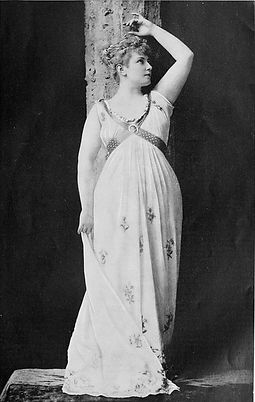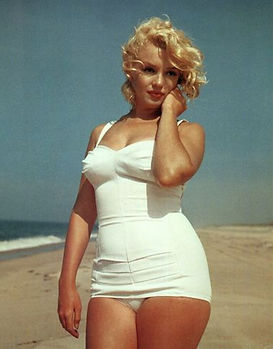The Ideal American Woman
19th To Early 20th Century
During the 19th century there were two trending body types: The Steel Engraving Lady and the Voluptuous Woman. These two body types shared a cinched waist, but that was their only similarity.

The Steel Engraving Lady
The Steel Engraving Lady's appeal came from her fragility; she was fashionably unhealthy. She was pale with rosy cheeks, her body was thin and petite, and she dressed in billowy clothing.

The Voluptuous Woman
As theater rose in popularity so did the curvaceous body type seen in its performers. The Voluptuous Woman with her full figure, big bust, and big hips had previously only been a popular body type among actresses and prostitutes. However, during the 19th century, she became briefly popular among upper-class women before returning to her lewd beginnings.
The Gibson Girl
The Gibson Girl possessed qualities of both older and newer beauty trends. She drew inspiration from the classy and slim Steel Engraving Lady of older trends, as well as the fuller busts and hips of the Voluptuous Women. From the newer trends she acquired her iconic hairstyle, hair piled on the top of her head, and her monobosom breast shape.

1920s
The curvaceous figure of the Gibson Girl was replaced by the boyish figure of the Flapper. Flappers often wore clothing that flattened their bodies, concealing or minimizing traditionally feminine curves and characteristics. Flappers sported short, shapeless dresses and favored a stylish bob haircut, which replaced the piled-up hairstyles of the Gibson Girl.
The Flapper was known for her carefree attitude and independent lifestyle, often frequenting parties and social events.



The Flapper
Advertisement For Flattening Garments
1930s and 1940s
In 1942, the Metropolitan Life Insurance Company (MetLife) released a chart detailing the ideal weight range for women who were 25 years and above, taking into account different bone frame sizes classified as small, medium, and large.
The creators of weight charts and tables began to exclusively list weight
The popularity of boyish figures came to an end, and a renewed emphasis on curves and feminine shape emerged. Narrow waists were once again in style accompanied by big breasts and longer skirts.
During this time a new beauty emerged: the Petty Girl. The Petty Girl was a fictitious woman drawn by pinup artist George Petty for Esquire magazine. The Petty girl was sexy; she had spherical breasts, a taut stomach, a small behind, small hips, and an even smaller waist as well as her best feature, long, smooth legs. In 1940, Alberto Vargas replaced George Petty as the Petty Girl's illustrator. Vargas slightly changed the Petty Girl, enlarging her breasts.



LegsLegsLegs

Legs were the new erotic symbol. One of the most popular pinups of the ’40s was Betty Grable and her “million dollar legs".
ranges considered "desirable" instead of providing average
statistics. The MetLife tables were used in several fashion magazines to help their readers set weight goals, but some magazines made up their own weight charts.
The Petty Girl
Illustrated by Petty
Weight Charts
Illustrated by Vargas
1950s
During the 1950s, two contrasting types of female beauty appeared: the sophisticated and refined High Fashion Model and the provocative and sexual Pin Up Girl. While both shared an hourglass figure, similarities between the two ended there.
The High Fashion Model
The Pin Up Girl

These classy ladies were chic and sophisticated with their tall slim figures and short cropped hair.
These curvaceous and big breasted women were the stars of Playboy magazine. The High Fashion Model had elegance, but the Pin Up Girl had sex appeal


Advertisement for girdles which helped create an hourglass shape
1960s
In the 1960s there was a significant shift towards a slimmer, more androgynous ideal body type. This trend was largely driven by the fashion industry, particularly the emergence of the miniskirt which became extremely popular and encouraged women to show off their legs and emphasize their slimness.
This trend towards slenderization was further amplified by the emergence of supermodel Twiggy, whose emaciated androgynous look was seen on the cover of every magazine. This angular body represented freedom and modernity as it differed from the curvier, more traditionally feminine ideal body type.



1970s to Present Day
For many years the bodies of full figured women were celebrated, as seen in the work of Peter Paul Rubens. However, this changed when enslaved Africans were brought to England. Stereotypes about black people immediately started to emerge throughout England and the Western world, including the belief that black people were fat. People spoke about the physical and mental inferiority of black people and how the two were connected. Due to these negative associations, everything potentially similar to black people, such as fatness, went out of style.
In the United States, these ideas were prominently displayed in media such as magazines. Articles claimed that fat women could only be considered beautiful in "savage" countries. There have been periods, such as the 1950s, when women with slightly fuller figures were considered fashionable. However, even during those times, these women were often sexualized rather than appreciated for their beauty, like the 1950s Pin Up Girl. Although body ideals have evolved since the 1960s, the notion of thinness being ideal has persisted until today. Although the racist reasoning behind this beauty standard has largely disappeared, anti-fatness and the thin ideal remain prevalent in society. While people may not consciously dislike fatness due to its association with blackness, it's important to examine the origins of the thin ideal.



